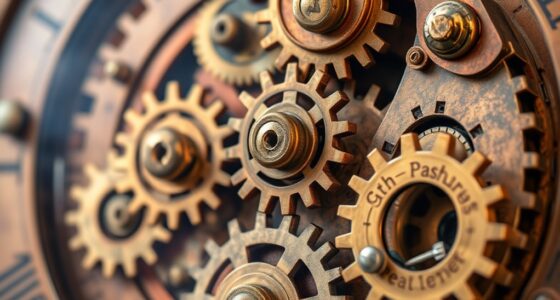Gears and cogs in steampunk machines are essential for transmitting power and movement, working together like a complex, interconnected network. These intricate components not only keep the machinery running smoothly but also serve as decorative symbols of Victorian craftsmanship and ingenuity. By turning and meshing, they demonstrate mechanical mastery and a sense of progress rooted in history. If you want to discover more about how these fascinating parts create the steampunk aesthetic and function, keep exploring.
Key Takeaways
- Gears and cogs interlock to transfer rotational energy, enabling precise mechanical movements in steampunk machines.
- They work together in gear trains to amplify torque and control speed within complex mechanisms.
- Their intricate design and ornamentation reflect Victorian craftsmanship, blending utility with aesthetic appeal.
- Gears synchronize different parts of a device, ensuring seamless operation and coordinated function.
- As symbols of innovation, they embody technological mastery and the interconnectedness of Victorian-era engineering.

Gears and cogs form the heart of steampunk design, embodying the genre’s obsession with intricate machinery and Victorian-era innovation. When you look at steampunk inventions or fashion, you can’t help but notice how these mechanical components reflect a unique Victorian aesthetic. The Victorian era was a time of technological marvels and elegant craftsmanship, and steampunk artists draw heavily from that inspiration. You see it in the ornate details, the brass finishes, and the meticulous arrangement of gears that seem almost decorative as much as functional. These elements are not just about utility—they serve as a visual language that communicates sophistication, ingenuity, and a touch of Victorian grandeur. The mechanical symbolism woven into steampunk devices is deliberate; it signifies progress, mastery over technology, and a fascination with engineering prowess. Gears and cogs, in particular, stand as icons of this symbolism, representing the interconnectedness of machines and the seamless harmony of Victorian ingenuity. When you observe a steampunk contraption, you notice how each gear plays a role in the larger mechanism, much like the intricate social and technological networks of the Victorian age. These mechanical parts aren’t just functional; they carry a symbolic weight, embodying the idea that progress is built on detailed craftsmanship and relentless innovation. The visual appeal of these gears isn’t accidental—they evoke a sense of wonder and curiosity, encouraging you to appreciate the complexity behind what might seem like simple machinery. This mechanical symbolism is also a nod to the era’s faith in science and invention, emphasizing that technology is both a tool and a symbol of human achievement. The Victorian aesthetics influence every aspect of steampunk, from the way gears are designed to how they integrate into larger systems, creating a blend of art and engineering. The ornate, often decorative, nature of these cogs underscores a Victorian appreciation for beauty in utility. You can see this in the elaborate patterns carved into gears or the brass fittings that adorn them. Every gear and cog is a tribute to the era’s craftsmanship and a reflection of the Victorian obsession with combining form and function. Ultimately, these mechanical symbols serve as a bridge to the past, connecting you to a time when innovation was celebrated through intricate design and symbolic craftsmanship. Steampunk’s gears and cogs aren’t just mechanical—they’re visual stories of Victorian aesthetics and mechanical symbolism, capturing the spirit of an age forever fascinated with pushing boundaries through beautiful, complex machinery.
Frequently Asked Questions
How Are Tiny Gears Manufactured for Intricate Steampunk Devices?
You manufacture tiny gears for intricate steampunk devices by using precise CNC machining and fine metalworking. First, you cut and shape the gears, paying close attention to gear alignment for smooth operation. To guarantee maximum performance, you lubricate the gears properly, reducing wear and tear. This careful process guarantees that each gear meshes perfectly, providing reliable power transfer essential for your detailed steampunk contraptions.
What Materials Are Most Durable for Steampunk Gear Construction?
You should choose metal alloys like brass, steel, or bronze for durable steampunk gears. These materials offer excellent material durability, resisting wear and corrosion over time. Brass is lightweight and easy to shape, while steel provides strength for high-stress parts. Bronze balances durability and aesthetic appeal, making it a popular choice. Selecting the right alloy guarantees your gears stay functional, reliable, and true to the steampunk style.
How Do Gears Synchronize Complex Steampunk Machinery?
You synchronize complex steampunk machinery through precise gear ratios and gear trains. By carefully designing gear sizes and tooth counts, you guarantee each gear turns at the correct speed, transmitting power smoothly. Connecting multiple gears in a gear train allows you to achieve intricate movements and timing, making sure every part works harmoniously. This meticulous coordination keeps your steampunk machines running efficiently and beautifully, showcasing the elegance of clockwork engineering.
Can Gears Be Customized for Aesthetic or Functional Purposes?
Yes, you can customize gears for both aesthetic and functional purposes. Gear aesthetics allow you to add intricate engravings, unique finishes, or colorful accents that enhance your machine’s visual appeal. Gear modifications improve performance, such as altering tooth design for smoother operation or increased strength. By personalizing gears, you create machinery that’s not only efficient but also visually striking, reflecting your unique steampunk style and engineering preferences.
How Do Maintenance and Repairs Affect Gear-Operated Steampunk Machines?
Sometimes, a small misstep during maintenance reveals how vital your gear alignment methods and lubrication techniques are. When you keep gears properly aligned and well-lubricated, repairs become smoother, preventing breakdowns. Neglecting these details can cause friction, wear, or even total failure. So, by paying attention to these maintenance aspects, you guarantee your steampunk machines keep running seamlessly, reminding you that precision and care hold everything together in this intricate world.
Conclusion
Now, imagine walking through a bustling steampunk city where every movement relies on intricate gears turning in perfect harmony. Just like a clockwork automaton you see in a museum, these machines showcase how gears and cogs bring steampunk inventions to life. By understanding their silent, precise work, you appreciate how this mechanical magic fuels innovation, blending artistry with engineering. Gears truly are the beating heart of steampunk, powering a world where imagination and craftsmanship collide.









